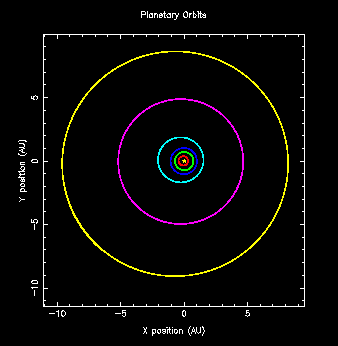
Project 63: Solar System Dynamics

The general blurb for this project goes like this:
You are not required to write or run any software yourself. The code will
not be modified by you (though we can certainly discuss various aspects as
the project progresses and I may be able to modify the program for
you) and it is run on our machines here at Swinburne. You will, however,
need to be logged on to the Internet while working on the numerical
experiments.
Good luck!
This site is to help those of you who have chosen to do the Solar System
Dynamics project for Swinburne Astronomy Online.
In this project you will be using the
Swinburne supercomputer
to run a
series of simulations via a web interface to investigate planetary
dynamics. To do this project you will have to be comfortable with
mathematics and computers - though you are not expected to write your
own computer code, you will need to do some algebra. To achieve high
marks in this project you will need to explore the equations that
govern the dynamics of the Solar System and explain the difference
between numerical and physical instabilities by try to produce
unstable planetary systems!
 The idea of the project is to use a pre-existing numerical code to
investigate the dynamics of the Solar System. There is an input file
which contains parameters that you can alter to run a series of
numerical experiments. This will be done using a webpage interface
(see below). The results from each numerical experiment will be displayed
back to you, which you should keep a copy of or print.
The idea of the project is to use a pre-existing numerical code to
investigate the dynamics of the Solar System. There is an input file
which contains parameters that you can alter to run a series of
numerical experiments. This will be done using a webpage interface
(see below). The results from each numerical experiment will be displayed
back to you, which you should keep a copy of or print.
 There are three main aspects to the project:
There are three main aspects to the project:
This project should give you an understanding of how numerical astrophysicists
approach and solve problems. A good place to start would be with your textbook. Read up on the
basic background material in the chapter Gravitation and the Motions of the
Planets (Universe, Kaufmann and Freedman). You may also want to
read the section on extrasolar planets and the essay on Aliens Planets.
If you have The New Solar System (Beatty, Petersen & Chaikin), you could
read the sections on the origin of the Solar System and other planetary systems.
This will give you a general idea of how to attack this topic.
A good place to start would be with your textbook. Read up on the
basic background material in the chapter Gravitation and the Motions of the
Planets (Universe, Kaufmann and Freedman). You may also want to
read the section on extrasolar planets and the essay on Aliens Planets.
If you have The New Solar System (Beatty, Petersen & Chaikin), you could
read the sections on the origin of the Solar System and other planetary systems.
This will give you a general idea of how to attack this topic.
 You could then do a detailed websearch on "solar system dynamics",
"planetary dynamics", "planetary motions", "celestial mechanics", "gravitation"
and variations on those themes.
You could then do a detailed websearch on "solar system dynamics",
"planetary dynamics", "planetary motions", "celestial mechanics", "gravitation"
and variations on those themes.
 Here are a couple of websites that might be a good place to start:
Here are a couple of websites that might be a good place to start:
Don't forget to use me as a resource too. If you're stuck or just need a
little guidance, feel free to email me and I'll be happy to help out.
Ok - enough talk - tell me more!
